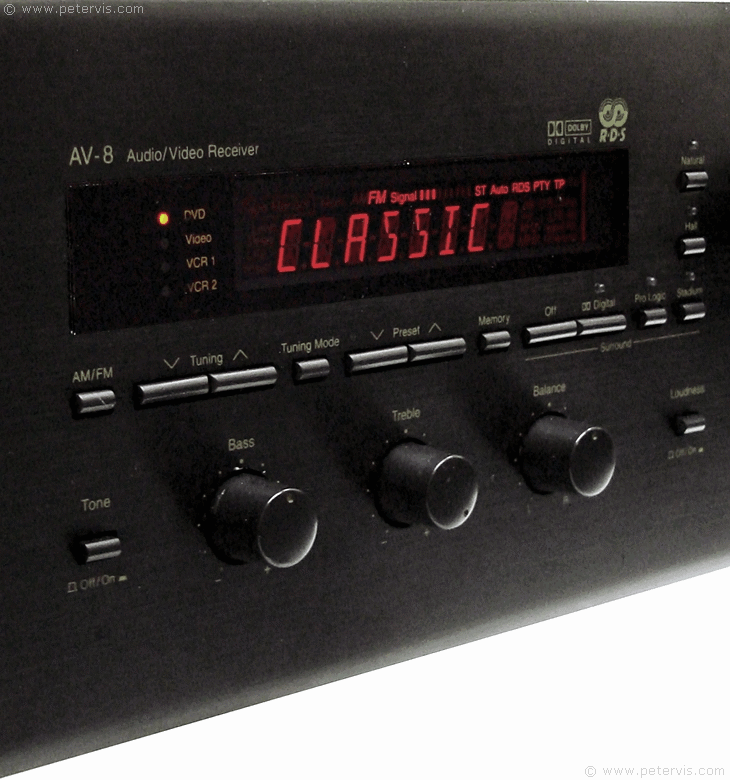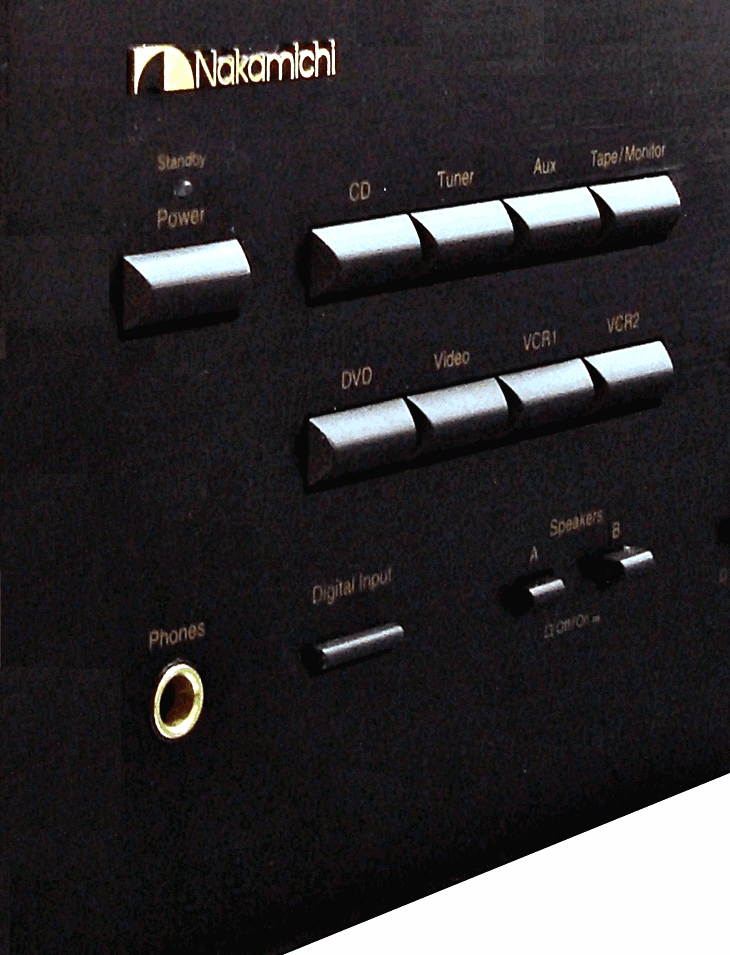Nakamichi AV-8


The AV-8 Audio/Video Receiver is one in a series of amplifiers with Harmonic Time Alignment (HTA™), manufactured in Malaysia by the Nakamichi Corporation. The other amplifiers in the series consist of AV-7, and AV-10, which look very similar with similar build design, electronics, and remote control. The AV-10 has 120-watts output capacity in stereo, and 100-watts per channel in surround sound mode, whilst the AV-7 and AV-8 provides 100-watts per channel in stereo and 80-watts per channel in surround mode. The AV-10 has DTS, Dolby Digital, and Pro Logic capability, whilst the AV-8 has Dolby Digital and Pro Logic, and the AV-7 has Pro Logic only. Even though the AV-8 does not have DTS, it is still a very desirable amplifier due to the unique HTA technology, and many audio enthusiasts and purists, prefer this amplifier in stereo mode for the best sound reproduction. Certainly, if you already have a Nakamichi cassette deck, then the next step is to get one of their amplifiers for the ultimate in sound quality reproduction. According to the AV-8 service manual the dynamic power output per channel is 120-watts with 8 Ω loudspeakers, hence, with five channels, this amplifier is capable of providing a total of 600-watts of power.

In the following pages of this multi-page article, you can see that this is a discrete-component power amplifier design, which according to Nakamichi, is far superior than IC power amplifiers. Consequently, the front and centre channels consist of 2SA1943 and 2SA5200 complementary pair of power transistors manufactured by the Toshiba Corporation, and the rear channels consist of 2SA1962 and 2SC5242 complementary pair. In addition, discrete transistors on the same circuit board, drive these power transistors, and since this Nakamichi design has to have additional transistors in each channel to provide the HTA functionality, it results in a very large beast of an amplifier with dimensions 430 mm × 140 mm × 370 mm and mass 14 kg.

Apart from the Nakamichi designers, very few people actually know what HTA really is in terms of Physics and Electronics. The Brochure literature simply gleans over it stating that this unique approach to amplifier design maintains the correct timing relationship between the signal and its distortion components resulting in exceptional sonic definition, transparency, and the most natural untiring music reproduction.

I was listening to this amplifier with a cheap pair of test speakers and the sound quality certainly is remarkable compared to other amplifier designs that use the same type of output transistors. The sound quality has that warm rich definition that is very reminiscent of valve (tube) amplifiers. If you like playing the bass guitar, then you might actually like this amplifier just for that purpose.

For my English friends in the UK, this amplifier has a motorised volume control knob, and in the following pages of this multi-page article, you can see the motor that drives this knob.

This amplifier was down on its luck and what it needed was a miracle. Luckily, it came to me and after that, it could only get better. Each issue required tracking and repair until it was 100 % operational. When colleagues learned that I was working on a Nakamichi, there were over a dozen offers on the table, and finally, after repair, it went to a good home of an audio enthusiast to become part of his collection.
Nakamichi hi-fi tends to have these wonderful red coloured displays that is very distinctive of their style. After a successful repair of this amplifier, I was listening to ClassicFM radio.
Cost/eBay

Nakamichi amplifiers usually hold their value because they are highly desirable and the HTA technology that they employ is impossible to find elsewhere. Very few amplifiers exist today because very few people could afford them in the first place. You will very likely find more owners in America than UK for that reason. A good working amplifier in mint condition, with the remote control, manual and box, could sell for well over several hundred pounds. A used condition one without the remote could sell for around three to four hundred pounds, and a broken burnt-out one could sell for around one hundred pounds.
Should you buy a broken Nakamichi amplifier? Consider that you will be unlikely to find the service manual and will have to diagnose the fault using your electronics experience. Also, consider that the replacement components and parts will be expensive. In addition, consider that this is a huge amplifier with subsystems requiring experience and knowledge of the electronic design that the Japanese employ. Their circuit protection and overload detection uses a computer IC and repairing it can be challenging for even the "expert" Brit; therefore, I would seriously advise against it. Even if you have "A" grades from the Blair education era, and lofty memberships to IEEE, and Royal institutes, it is not going to be enough!
If you are an audio enthusiast who already has a Nakamichi tape deck, then a nice working amplifier to match it is probably the next step to take. The good news is that these amplifiers can often sell cheaply and therefore it is an ideal opportunity to fill up that rack space with Nakamichi's. In any case, before you rush off to eBay to buy one, finish looking at the remaining pages of this multi-page article, which might help decide to buy.
This Article Continues...
Nakamichi AV-8Nakamichi AV-8 inside Look
Nakamichi AV-8 Heatsink Assembly Cleaning
Nakamichi AV-8 Audio Power Output Assembly
LC865624 Control Processor
Nakamichi AV-8 Service and Repair
Nakamichi AV-8 Front PCB
Nakamichi AV-8 Power Supply System
Nakamichi AV-8 Speaker Protection System
Nakamichi AV-8 Volume Control Board
Nakamichi AV-8 Digital Board
Nakamichi AV-8 Tuner Board
Nakamichi AV-8 Main Board PCB
Nakamichi AV-8 Back Sockets
Nakamichi AV-8 Specification